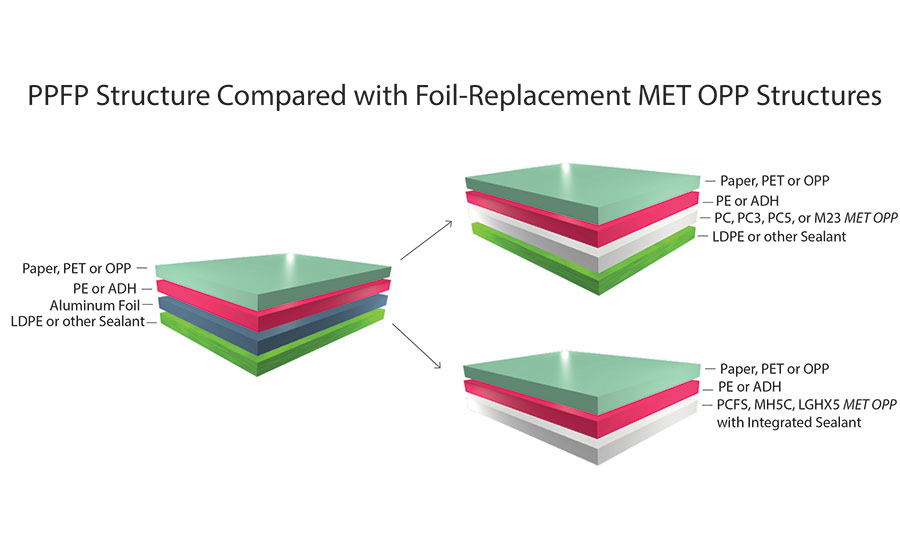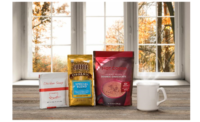For decades, food manufacturers have been reaping the benefits of switching from foil-based flexible structures to metallized film-based packaging. Given the U.S. Department of Commerce’s recent decision to impose tariffs on aluminum foil imported from China, Toray Plastics (America) (www.toraytpa.com) anticipates that end users will want to substitute foil with metallized films at an even greater rate. In this interview, Tammy Williamson answers questions about what to consider in redesigning a foil-based packaging structure with a metallized film and point out the benefits of metallized films.
What are the foil-replacement applications for metallized film?
Metallized (MET) films encompass biaxially-oriented polypropylene (BOPP), polyester (PET), nylon and cast OPP, and are manufactured by means of high-speed vapor deposition. In this article, the focus is on metallized BOPP and PET. The quality of the base film and the integrity of the metal coating process are critical for the success of an application. When those fundamentals are in place, metallization can significantly improve the oxygen and moisture barrier durability of a film, make for an opaque barrier to light and offer a high-reflective, glossy appearance.
A popular MET OPP application is a drop-in foil replacement for traditional paper-polyethylene-foil-polyethylene (PPFP) packet and stand-up packaging (SUP) used for salty snacks, oatmeal, hot cocoa, seasonings, dried soups, rice, dried cheese, mixes and powdered beverages. It is also sought after as a replacement for foil in packaging structures for nutritional bars. MET PET film is an ideal foil-replacement solution for coffee, nuts, dried fruits and powdered nutritional or energy drink packaging. It’s also an excellent choice for replacing foil in a lidding application for dairy foods, like yogurt and ice cream, though challenges may present themselves depending on the filling equipment used.
Will the tariff on aluminum foil have any effect on the price of aluminum used to manufacture MET films?
The thickness of the vacuum deposited metal is only a few hundred Angstroms, so while there will an impact on the price of the films, it will be negligible compared to what we forecast for aluminum foils.
What are the benefits to be gained from a switch to metallized films?
MET OPP film offers flex-crack and puncture-resistance, gas-barrier durability, yield, economic and aesthetic benefits equal to or better than those of foil, and it runs well on pouch lines. Metallized film technology, including MET PET for packaging, continues to evolve and find new applications. Among the advances made are thin and ultra-thin films, which offer source reduction, improved barrier; sealant coatings that offer improved hermetics (air tightness); and seal-strength functionality, and other specialty coatings. With a lower density, MET films deliver more surface area per pound than foil and are a smart, sustainable choice, yet they maintain strong package-processing characteristics.
What are the differences between MET OPP and MET PET?
MET PET typically has superior oxygen barrier and good moisture barrier, whereas MET OPP offers excellent moisture and good oxygen protection. MET PET’s bond strength and the general robustness of a lamination are superior to those associated with MET OPP. There is less extensibility during laminating and pouching with MET PET due to the higher strength of the film, particularly at high seal temperatures.
MET OPP delivers excellent moisture barrier, very good oxygen barrier, barrier to light, a highly reflective gloss, better puncture resistance and excellent flex-crack resistance compared with foil, all of which can be achieved at a relatively low cost.
MET OPP is often designed with a low seal initiation temperature (SIT) heat-seal layer allowing it to be used in a two-layer lamination. MET PET doesn’t always have this type of heat-seal functionality and is often utilized in a triplex laminate.
If a CPG company switches from foil to MET films, isn’t barrier durability a concern?
Gelbo flex testing, the simultaneous twisting and crushing of a packaging film lamination to represent packaging handling, is industry protocol and a standard indicator for the comprehensive robustness of a lamination. It reveals the lamination’s ability to withstand repetitive strain and resistance to flex-cracking, pinholing and delamination. Studies have shown that once one begins flexing a lamination made with foil, such as PPFP, the laminate cracks and pinholes and gas transmission rates increase. A paper lamination made with MET OPP is much more durable and shows significantly less gas-barrier loss (i.e., less increase in gas transmission) over the same number of flexes. The thin metallized layer of the MET Film is more ductile than foil, and enables it to withstand more flexing without exhibiting deadfold wear.

How is sealing affected by a switch?
Metallized films are available with or without integrated sealant technology. Integrated sealant technology means that the MET OPP or MET PET film has a heat-sealable layer or functionality built into it without its requiring an additional processing step, so the need for the addition of a separate sealant web or coating is eliminated.
The additional feature of integrated sealant technology allows for the replacement of the foil and extrusion-coated sealant layers or separate sealant films. Depending on the type of product to be packaged, integrated sealable metallized films can be selected or designed to work very well with that product, and, if necessary, provide seal-through-contamination properties.
Integrated sealant technology also offers source reduction, as it eliminates the need for an LDPE or other sealant layer.
Are package aesthetics affected by a switch?
A finished package made with MET OPP or MET PET is attractive and resilient. Foil possesses dead-fold characteristics and “memory” that make wrinkles and creases permanent. Packages made with film do not exhibit a “shop worn” appearance after distribution and handling.
What questions should a CPG company ask before making a switch?
When talking with a food manufacturer about a transition from foil to film, the first step is usually no different than when choosing any packaging film: understanding the functional performance needed for the application. In the case of foil replacement, what was the reason the customer chose foil in the first place? What gas-barrier level is required? How is the packaging going to be handled? Will the food product have sharp edges or points (think of dried pasta or dehydrated vegetable slices in a powdered soup mix)? If so, puncture resistance will be important. Is moisture barrier of greater concern than oxygen barrier, or are they of equal importance?
What about light, aroma and flavor barrier? Is FDA compliance necessary? Opening properties are also essential; film solutions require a notch. Stiffness and dead-fold characteristics should also be considered. Money always matters, so how do economics and yield requirements factor in? What equipment is to be used, and what are the targeted line speeds and processing temperatures and conditions? Also, what other application processing characteristics are needed, such as co-efficient of friction, which can contribute to more efficient processing and packaging manufacturing?
The conversation with the converter will certainly overlap with the conversation with the end user, but it will also explore questions germane to the converting process. How quickly can films be delivered and resupplied? Does the film exhibit good flatness? Foil can be challenging to run, so if the film has good flatness, it should run well on the equipment being used. A flat film will also help with the management of tension control. Good tension control is important to ensure that line speeds are not slowed. Different adhesives may be needed to create the new lamination.



